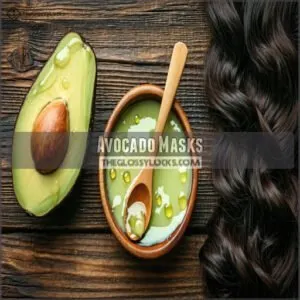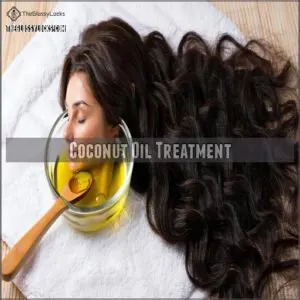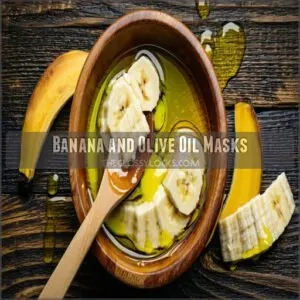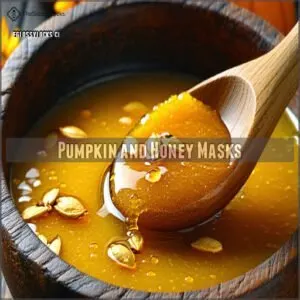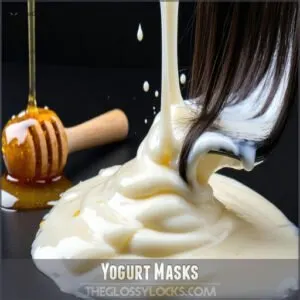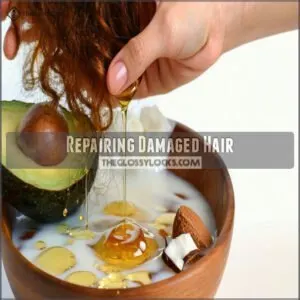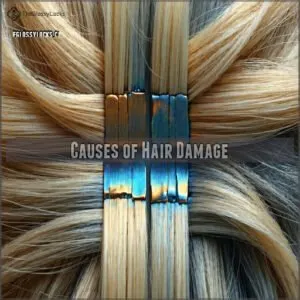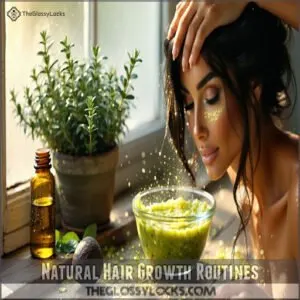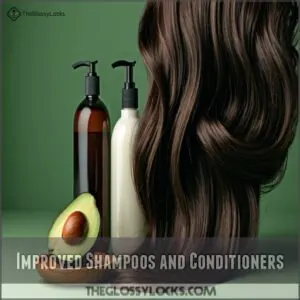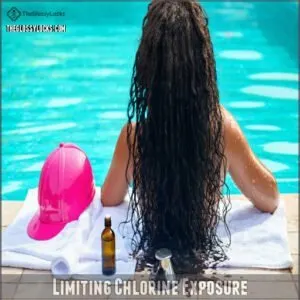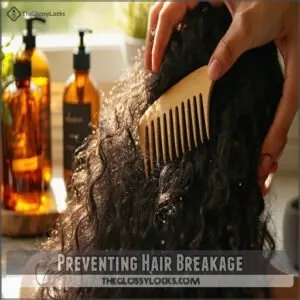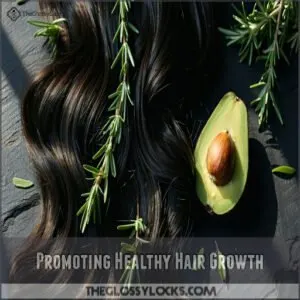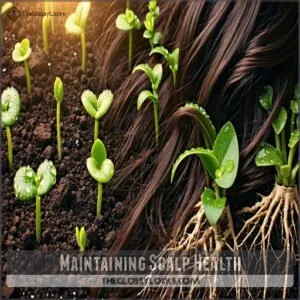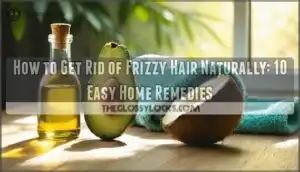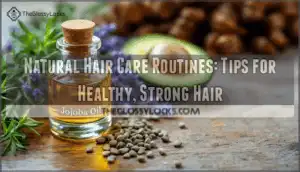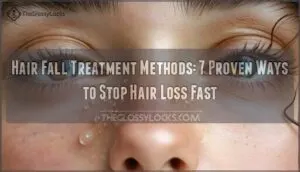This site is supported by our readers. We may earn a commission, at no cost to you, if you purchase through links.
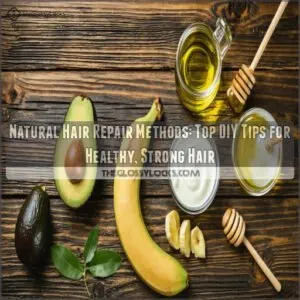
Natural hair repair methods are simpler than you’d think. Mix up a creamy avocado mask with olive oil for deep nourishment, or warm some coconut oil for an overnight treatment that’ll make your hair silky-smooth.
Got a banana going brown? Perfect timing – mash it with olive oil for a vitamin-rich mask. Even your morning yogurt can transform damaged strands, especially when paired with honey.
These ingredients work like magic to repair and strengthen your hair from root to tip. And that’s just scratching the surface of Mother Nature’s beauty secrets.
Table Of Contents
- Key Takeaways
- Hair Moisturizing Methods
- Natural Color Boosting
- Repairing Damaged Hair
- Causes of Hair Damage
- Natural Hair Repair Techniques
- Preventing Hair Breakage
- Promoting Healthy Hair Growth
- Maintaining Scalp Health
- Frequently Asked Questions (FAQs)
- How can I fix my damaged hair naturally?
- What is the best natural hair repair?
- How can I bring my hair back to life naturally?
- What is a good homemade hair treatment for damaged hair?
- How long should I wait between hair treatments?
- Can swimming pools permanently damage my hair texture?
- Does air pollution affect natural hair health?
- What role do genetics play in hair repair?
- When should I switch to professional hair treatments?
- Conclusion
Key Takeaways
- Treat your hair naturally with DIY masks like avocado with olive oil or banana with honey for deep moisture and repair.
- Use coconut oil for overnight treatments to strengthen strands and reduce frizz while enhancing shine.
- Avoid damage by switching to soft hairstyles, using heat protectants, and skipping wet combing to prevent breakage.
- Boost scalp health with weekly massages, PH-balanced shampoos, and clay scrubs to promote hair growth and clean roots.
Hair Moisturizing Methods
Keeping your hair moisturized is the secret to keeping it soft, shiny, and healthy.
From creamy avocado masks to rich coconut oil treatments, you’ve got plenty of simple, natural options to lock in hydration and banish dryness.
Avocado Masks
Avocado masks are like a spa day for your hair.
Packed with Vitamin E and B, avocados deeply nourish and repair.
Mash one avocado, add olive oil, and apply from roots to tips.
Let it sit for 30 minutes, then rinse.
This DIY natural remedy boosts hydration, smooths strands, and seals cuticles—perfect for natural hair repair!
Coconut Oil Treatment
Concerning hair repair remedies, coconut oil is like a magic wand for stressed-out strands.
This oil therapy deeply nourishes, repairs the scalp, and strengthens from root to tip.
Here’s how to use it:
- Warm a small amount of coconut oil.
- Massage into your scalp for repair.
- Smooth on ends for deep conditioning.
- Leave overnight.
- Rinse with mild shampoo for deep conditioning.
Banana and Olive Oil Masks
Your dry, tired tresses are in for a tropical treat! Whip up a DIY hair mask by mashing a ripe banana with olive oil for intense moisture.
This natural hair repair combo delivers potent nutrients that’ll transform your strands. Bananas pack vitamin B6 and potassium, while olive oil’s fatty acids penetrate deep into the hair shaft.
| Benefits | Application Tips | Results |
|---|---|---|
| Deep conditioning | Apply root to tip | Silky smoothness |
| Split end repair | Leave for 30 mins | Reduced breakage |
| Shine boosting | Use weekly | Enhanced luster |
| Frizz control | Warm oil slightly | Manageable hair |
| Natural moisture | Rinse thoroughly | Soft texture |
The benefits of this DIY hair mask include deep conditioning, split end repair, shine boosting, frizz control, and natural moisture, making it a comprehensive solution for common hair problems.
Pumpkin and Honey Masks
Along with taking care of your Halloween decor, put that pumpkin to work for your hair.
This natural remedy combines vitamin-rich pumpkin with honey’s humectant properties to create a powerhouse hair mask.
You’ll love how this DIY treatment deeply nourishes your strands while sealing in moisture.
Simply mix pureed pumpkin with raw honey, apply to damp hair, and let it work its magic for 20 minutes, using the humectant properties to your advantage.
Yogurt Masks
While pumpkin masks work wonders, you’ll love what yogurt can do for your locks.
This protein-packed natural hair mask strengthens your strands from root to tip.
You can find a variety of yogurt hair mask products.
Mix plain yogurt with a touch of honey, apply it to damp hair, and let it work its magic for 20 minutes.
Your hair will feel softer and look shinier, plus the lactic acid helps soothe your scalp.
Talk about a win-win!
Natural Color Boosting
You don’t need pricey salon treatments to give your hair color a natural boost at home.
Your kitchen pantry might’ve everything you need, with simple ingredients like cocoa powder for rich browns or lemon juice for sun-kissed highlights.
You’ll love how easy it’s to refresh your color while keeping your hair healthy.
Cocoa Powder
Your love for moisturizing treatments can blend perfectly with natural coloring methods.
If you’re looking to deepen your brown hair tones naturally, cocoa powder offers a rich, chemical-free solution. Mix two tablespoons of cocoa powder with your favorite conditioner for stunning results.
Here’s what makes cocoa powder amazing for your hair:
- Contains natural antioxidants that protect hair while coloring
- Creates depth without harsh chemicals
- Leaves your hair smelling subtly chocolatey
- Works gradually for a natural-looking result
- Doubles as a nourishing hair mask
Lemon and Chamomile Tea
You can brighten up your ashy blonde hair naturally with a revitalizing blend of lemon and chamomile tea.
Simply steep two chamomile tea bags in hot water, add fresh lemon juice, and let it cool.
Spray this natural hair lightening solution onto damp hair before heading outdoors.
The sun’s warmth activates these ingredients, gradually creating subtle, sun-kissed highlights that look completely natural.
Purple Kool-Aid Rinses
Those pesky brassy tones in your blonde hair?
Here’s a budget-friendly DIY hair repair trick: Purple Kool-Aid rinses work as a natural color neutralizer.
Mix unsweetened grape Kool-Aid with water to create a DIY color correction solution.
Just like professional hair toning treatments, the purple pigments help cancel out yellow undertones.
Apply this blonde care hack for 5-10 minutes, watching carefully to avoid over-toning your locks.
Raw Honey
While purple rinses tackle brassiness, raw honey offers a gentler approach to natural hair lightening.
This sweet kitchen staple does more than just brighten your strands – it’s a powerhouse of natural hair treatments.
Here’s what raw honey can do for your locks:
- Creates subtle highlights when mixed with water and left on damp hair for 30 minutes
- Softens and conditions while gradually lightening your strands
- Doubles as a homemade hair mask that won’t strip your natural oils
Walnut Powder
While raw honey works wonders for lightening, walnut powder offers a fantastic natural solution for darkening hair and covering those sneaky gray strands.
You’ll feel like a DIY hair wizard when you see the results! Here’s what you need to know about this time-tested natural dye:
| Walnut Benefits | Application Tips |
|---|---|
| Natural gray coverage | Mix with warm water |
| Long-lasting color | Apply with gloves on |
| Chemical-free dyeing | Leave for 30 minutes |
| Gradual darkening | Rinse thoroughly |
This natural dye has several benefits, including natural gray coverage and long-lasting color, making it a great alternative to chemical dyes.
Repairing Damaged Hair
If you’re tired of dealing with dry, dull, or frizzy hair that looks like it’s been through a battle with your styling tools, you’re not alone.
You’ll be amazed at how quickly you can transform your damaged locks into healthy, shiny hair using simple ingredients from your kitchen, and the best part is you won’t need to empty your wallet at fancy salons.
Dry and Dull Hair
While natural dyes can work wonders, you’ll need extra TLC if your hair’s looking lifeless and dull.
Your strands are probably thirsty! Oil treatments and hair masks are your new best friends.
Mix up a homemade hair mask with avocado and coconut oil to restore that moisture balance.
Deep conditioning treatments twice weekly will bring back your hair’s natural shine and bounce. Just remember – dry ends need consistent love to stay healthy.
Tangles and Frizzy Hair
Dealing with tangled, frizzy hair can feel like wrestling an octopus in a windstorm.
Here’s your guide to smoother, more manageable locks:
- Use a wide-toothed comb with a silk therapy leave-in conditioner to gently work through knots
- Apply coconut oil before bedtime, wearing a silk cap overnight
- Try a banana-honey hair mask weekly for natural frizz control
- Rinse with cool water to seal the cuticle
- Pat dry with a microfiber towel instead of rubbing to achieve smoother locks
Color Damage
Regarding color damage, your hair’s crying out for some TLC.
Instead of harsh chemical procedures, try henna or indigo for gentle color restoration. You’ll love how these natural dyes boost your color while healing damaged strands.
For fade prevention, mix coconut oil with your favorite toner application. It’s like giving your hair a spa day – you’re fixing the damage and keeping that gorgeous color locked in!
Consider natural remedies for damaged hair like rosemary oil or egg masks.
Breakage and Brittleness
While chemical treatments can leave your hair vulnerable, breakage and brittleness often sneak up on you like uninvited party crashers.
You’ll spot split ends, frizzy hair, and damaged strands acting up. For helpful tips, explore these frizzy hair home remedies.
Don’t panic – you’ve got options! Start with weekly hair masks for dry hair, switch to a wide-toothed comb, and give those brittle locks some TLC with coconut oil treatments.
Regular trims will keep those pesky split ends in check.
Causes of Hair Damage
You’ll be surprised how many everyday habits can turn your gorgeous locks into a hot mess, from cranking up your styling tools too high to skipping those much-needed trims.
Your hair’s worst enemies aren’t just the obvious ones like bleaching and heat styling, but also sneaky culprits like a poor diet, stress, and even that chlorine-filled pool you love so much.
Uncut Hairstyles
Time isn’t always kind to uncut hair.
When you skip those regular trims, split ends start creeping up your strands, causing breakage that travels upward.
You’ll notice your hair becoming increasingly brittle and prone to tangles.
Without proper hair growth maintenance through regular trims, those damaged ends can lead to thinner-looking hair overall.
Don’t let the fear of losing length stop you—regular trims actually promote healthier natural hair growth.
Heat Damage
While regular trims keep your ends healthy, those hot styling tools might be your hair’s secret nemesis.
Your morning routine with that scorching flat iron or blazing blow dryer can leave your strands feeling like crispy toast.
Heat damage wreaks havoc on your hair’s natural proteins, causing breakage and frizz.
- Use heat protection spray before styling – it’s like giving your hair a suit of armor
- Keep tools below 365°F (185°C) – higher temps literally cook your strands
- Try heatless styling methods twice a week – your hair deserves a vacation too
Bleaching
Breaking the bonds of your natural hair color through bleaching might sound exciting, but it’s like sending your strands through a war zone.
When bleach dissolves melanin, it’s not just changing color – it’s fundamentally altering your hair’s structure.
Here’s what happens during and after bleaching:
| Damage Type | How to Repair |
|---|---|
| Increased Porosity | Deep conditioning treatments |
| Protein Loss | Weekly protein masks |
| Brittleness | Bond-building products |
| Breakage Risk | Regular moisturizing oils |
To mitigate these effects, consider the following repairs:
Deep conditioning treatments for Increased Porosity, Weekly protein masks for Protein Loss, Bond-building products for Brittleness, and Regular moisturizing oils for Breakage Risk.
Diet and Nutrition
Your hair’s health starts from within, just like a garden needs rich soil to flourish.
A poor diet lacking essential nutrients can leave your locks looking lifeless and prone to damage.
Here’s what your hair craves for ideal growth:
- Load up on omega-3s from salmon and nuts for stronger strands
- Pack in iron-rich foods like spinach and lean meats
- Don’t skip biotin-rich eggs and avocados
Remember, whole foods beat supplements every time for nutrient uptake.
Stress and Environmental Factors
While stress wreaks havoc on your hair’s health, environmental factors can be just as damaging.
Air pollution and environmental debris cling to your strands, while UV exposure weakens hair fibers.
You’ll notice more hair breakage during high-stress periods, especially when combined with humidity changes.
Climate change’s unpredictable weather patterns don’t help either.
Try using UV protection products and maintaining good scalp health through regular cleansing to combat these challenges, and reduce hair breakage with proper care, including attention to scalp health.
Natural Hair Repair Techniques
You’ll be amazed at how simple kitchen ingredients can transform your damaged hair into soft, healthy locks without spending a fortune at the salon.
Whether you’re dealing with split ends, frizz, or dryness, these natural repair techniques will help you restore your hair’s natural shine and strength using ingredients you probably already have at home, which can lead to soft, healthy locks.
Natural Hair Growth Routines
Once you’ve identified what’s causing your hair troubles, you’ll love these natural growth routines that really work.
Start with weekly scalp massages using natural oils like rosemary or jojoba – they’re amazing for stimulating those sleepy follicles!
Mix up DIY hair masks using ingredients from your kitchen (hello, egg yolks and avocado!).
Plant-based growth factors can give your strands that extra boost they’ve been craving.
Improved Shampoos and Conditioners
Looking for game-changing hair care products? Your journey to healthier locks starts with sulfate-free shampoos and natural ingredient-packed conditioners.
Many people choose sulfate free shampoo products for healthier hair.
Here’s what you’ll love:
- Deep conditioning masks with avocado oil deliver essential nutrients, making dry strands silky smooth
- Co-washing with gentle formulas keeps natural oils intact while cleansing
- PH-balanced leave-in conditioners provide ongoing protection and lasting moisture
Think of these improved formulas as your hair’s daily multivitamin!
Regular Trims
Every six to eight weeks, you’ll need regular trims to keep your hair looking its best.
Getting those splits snipped isn’t just about style – it’s your ticket to healthier, stronger locks.
Here’s a quick guide to help you stay on top of your trim game:
| Trim Frequency | Signs You Need a Trim | Benefits |
|---|---|---|
| 6-8 weeks | Split ends visible | Prevents breakage |
| 8-10 weeks | Tangled ends | Promotes growth |
| 10-12 weeks | Rough texture | Maintains shape |
| 12-14 weeks | Visible damage | Improves thickness |
| 14-16 weeks | Excessive shedding | Enhances shine |
Avoiding Wet Hair Combing
Your hair’s at its most fragile when wet, making it super prone to breakage. Even that trusty brush you love can turn into a hair villain when your strands are soaked.
Here’s what to do instead:
- Let your hair air-dry until it’s about 80% dry before reaching for any brush
- Use a wide-toothed comb to gently detangle from ends to roots
- Apply a leave-in conditioner before attempting any detangling
- Pat hair dry with a microfiber towel instead of rubbing
- Keep a special detangling brush just for damp hair care
Limiting Chlorine Exposure
Swimming pools can wreak havoc on your locks, but you can shield your strands from chlorine damage with some smart moves.
Before diving in, wet your hair with clean water and apply coconut oil – it’ll create a protective barrier.
You’ll also want to wear a swim cap and rinse thoroughly after swimming.
Installing a water filter in your shower helps remove lingering chlorine, preventing ongoing damage.
Preventing Hair Breakage
You don’t have to watch your hair break off in frustration every time you style it.
With a few simple changes to your daily hair care routine, like using a wide-toothed comb and turning down the heat on your styling tools, you’ll see fewer strands in your brush and more bounce in your step.
Using Wide-Toothed Combs
You’re probably reaching for that fine-toothed comb every morning, but here’s a secret: wide-toothed combs are your hair’s best friend for gentle detangling and preventing breakage.
They’re especially essential when your hair is wet and most vulnerable. For additional tips, explore this guide on preventing hair breakage.
- Start from the bottom and work your way up
- Use slow, deliberate strokes to minimize tension
- Hold sections firmly near the roots while detangling
- Spray leave-in conditioner before combing wet hair
- Choose wooden combs for less static and smoother detangling, which helps in preventing breakage and promoting healthy hair care with gentle detangling.
Avoiding Tight Hairstyles
You might be rocking those sleek ponytails and braids, but tight hairstyles can wreak havoc on your hair’s health.
When you constantly pull your hair back with hair ties, you’re creating scalp tension that leads to hair slippage and breakage.
Instead, try gentle styling alternatives like loose buns or soft braids. These style alternatives won’t compromise your hair follicle health while still keeping you looking fabulous.
Reducing Hot Appliance Temperatures
Beyond protecting your strands from tight styles, let’s tackle another sneaky hair destroyer – those scorching hot tools.
You wouldn’t cook your dinner on maximum heat, so why blast your precious locks with super-high temperatures? Here’s your game plan for heat protection:
- Start with the lowest effective temperature for your hair type
- Never exceed 365°F (185°C) for fine hair
- Use heat protectant spray before styling
- Keep the appliance moving constantly
- Allow hair to cool completely before touching or styling further
You’ll be amazed how much healthier your hair looks when you turn down the heat. Plus, your styling tools will last longer too – talk about a win-win!
Promoting Healthy Hair Growth
You’ll be amazed at how your hair can transform from lackluster to luscious with the right mix of nutrients and care.
Whether you’re dealing with stubborn split ends or dreaming of mermaid-length locks, we’ll show you how to nurture your hair from the inside out with simple, proven methods that won’t break the bank, using a simple approach.
Balanced Diet
While protecting your hair from breakage is key, what you eat plays a starring role in your hair’s health.
Your hair loves a whole food diet packed with lean meats, colorful fruits, and plenty of veggies.
Think of nutrient uptake like feeding your hair a gourmet meal – healthy fats from nuts and seeds work wonders, while protein-rich foods help build stronger strands from the inside out.
Essential Vitamins and Minerals
While eating well sets the foundation, specific vitamins and minerals work like tiny hair superheroes.
Your hair loves vitamin E for repair, while iron deficiency can lead to thinning – so load up on those leafy greens.
Biotin benefits include stronger strands, and zinc supplements help maintain healthy follicles.
Don’t forget niacinamide, which keeps your scalp happy. Think of vitamins for hair as your strands’ daily multivitamin boost!
Hydration and Moisturizing
Your hair’s daily thirst can’t be quenched by vitamins alone.
Keep those strands happy with deep conditioning treatments twice a week – think coconut oil or avocado masks that’ll make your hair feel like silk.
Understanding hair porosity and product selection is important for effective moisturizing.
Mix up a moisturizing mask with honey and banana, or treat yourself to a leave-in conditioner that’ll keep working all day.
Remember, well-hydrated hair is stronger, shinier, and far less prone to breakage.
Protecting Hair From Damage
With damage lurking around every corner, you’ll want to shield your precious strands from harm.
Start by wrapping your hair in a silk scarf at night to prevent friction damage.
When swimming, apply coconut oil beforehand as a natural barrier against chlorine.
Don’t forget to use heat protectant sprays before styling, and always opt for gentle, sulfate-free shampoos to maintain your hair’s natural oils.
Maintaining Scalp Health
You’ll be amazed at how much your hair’s health depends on what’s happening up top, right where it all begins.
Just like a garden needs healthy soil to grow beautiful flowers, your scalp needs proper care to grow strong, vibrant hair.
Scalp Massage
Three minutes of daily scalp massage can transform your hair’s health by boosting circulation and nourishing those hungry follicles. You’ll love how this simple technique wakes up sleepy roots and gets the blood flowing – it’s like sending your scalp to the spa!
- Use your fingertips to make small, circular motions across your scalp
- Apply gentle pressure while massaging from front to back
- Spend extra time on the crown and temples where tension builds up
- Try alternating between light tapping and kneading movements
- Massage before bed to help you relax while stimulating follicle health
Bentonite Clay Scrubs
After giving your scalp a good massage, you’ll want to clear away any buildup.
Bentonite clay scrubs are your secret weapon for a deep scalp detox. You can find a variety of bentonite clay scalp scrub products.
This natural wonder pulls out impurities like a magnet, while adding beneficial minerals to your hair follicles.
Mix the clay with water or apple cider vinegar, apply it to your scalp, and let it work its magic for 15-20 minutes, which is a simple yet effective way to achieve a natural detox.
PH-Balanced Shampoos
While bentonite clay works wonders for deep cleansing, your daily hair care routine needs a gentler touch.
That’s where pH-balanced shampoos come in – they’re like a cozy blanket for your scalp!
These sulfate-free formulas maintain your hair’s natural balance, preventing that squeaky-clean feeling that actually signals stripped oils.
For those with scalp irritation, exploring shampoos for dry itchy scalps can provide relief.
You’ll love how these gentle cleansers keep your locks happy without disrupting your scalp’s protective barrier.
Avoiding Harsh Chemicals
Many commercial hair products pack a punch of harsh chemicals that can wreak havoc on your scalp.
You’ll want to switch to gentle shampoos with natural oils instead of sulfates and parabens.
Try DIY hair masks using organic products like coconut oil or aloe vera.
Check those ingredient labels – if you can’t pronounce it, your hair probably doesn’t need it in your hair care routine with harsh chemicals.
Frequently Asked Questions (FAQs)
How can I fix my damaged hair naturally?
Over 80% of women face hair damage from daily styling.
You’ll see great results using weekly avocado masks, coconut oil treatments, and gentle washing methods.
Don’t forget to trim those split ends regularly!
What is the best natural hair repair?
Coconut oil’s your hair’s best friend – apply it weekly for deep repair.
You’ll also love avocado masks for sealing cuticles, and don’t forget regular trims.
These simple tricks keep your locks healthy and strong.
How can I bring my hair back to life naturally?
Give your hair a fresh start!
Use avocado masks for moisture, coconut oil for strength, and yogurt for shine.
Trim split ends, avoid harsh products, and massage your scalp.
Healthy hair needs love and patience!
What is a good homemade hair treatment for damaged hair?
Try an avocado and olive oil mask!
Mash one ripe avocado, mix with two tablespoons of olive oil, and apply it to your hair.
Leave it on for 30 minutes, then rinse.
Your hair will thank you for using this avocado and olive oil treatment!
How long should I wait between hair treatments?
Wait at least a week between treatments to avoid overwhelming your hair.
Too much love too fast can backfire!
Let your strands breathe, recover, and enjoy the benefits of each treatment before piling on another.
Can swimming pools permanently damage my hair texture?
Chlorine in pools can strip natural oils, making hair dry and brittle.
While it’s not permanent, repeated exposure without protection can roughen your hair’s texture.
Wear a swim cap or use pre-swim conditioners for defense!
Does air pollution affect natural hair health?
Air pollution can mess with your hair’s health, leaving it dry, dull, and weak.
Dust and toxins build up on your scalp, clogging pores and stressing follicles.
Regular washing and protective oils can help.
What role do genetics play in hair repair?
Imagine your hair like a family heirloom—it reflects your genetic makeup.
Genetics shape your hair’s texture, density, and strength, so while you can mend damage, your DNA ultimately sets the foundation for repair limits.
When should I switch to professional hair treatments?
You should consider professional hair treatments when home remedies no longer deliver noticeable results.
Your damage feels unmanageable, or you’re dealing with severe issues like breakage, thinning, or post-chemical treatment stress.
Sometimes, experts are lifesavers!
Conclusion
Think of your hair as a garden—nourish it with the right natural hair repair methods, and it’ll thrive.
Simple DIYs like avocado masks, coconut oil treatments, or banana blends can breathe life into tired strands.
Keep things healthy by trimming split ends, eating well, and avoiding harsh heat.
Treat your scalp, too—it’s the root of great hair!
With these care tips, you’ll keep your locks strong, shiny, and ready to handle anything life throws at them, using natural methods.
- https://www.healthline.com/health/home-remedies-for-dry-hair
- https://parade.com/1304956/shelby-deering/home-remedies-for-damaged-hair/
- https://pantene.com/en-us/articles/using-a-hair-repair-treatment
- https://www.carolsdaughter.com/blog/hair/hair-care-tips/how-to-repair-natural-hair.html?srsltid=AfmBOoqyIlpvhRpTDridICbEc3kt3MQW0-Go_jqt0YwUIYKnwh0Fh7qo
- https://naturallclub.com/blogs/the-naturall-club-blog/9-easy-tips-to-deal-with-damaged-natural-hair?srsltid=AfmBOorU1ix7pAhp91fXbwLCXbv7jrWAiz_lhWtcZdAh4zGhvWrJXKT4

